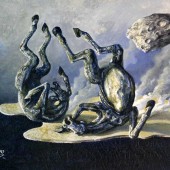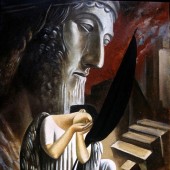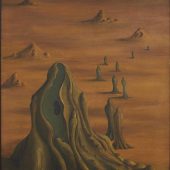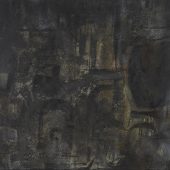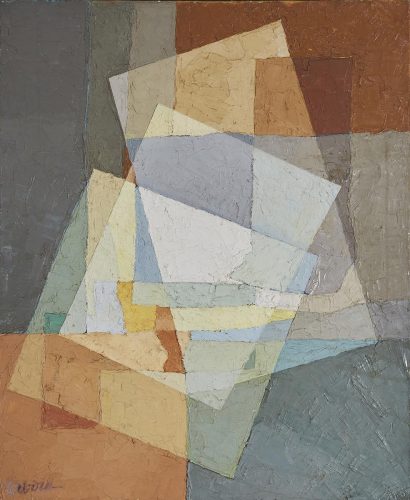
Celebrated for his portraits, Muhanna Al-Durra is recognised as one of the first painters in Jordan to experiment with abstract compositions. As in this 1970 work, his abstractions explore light and dynamism. Often directing movement diagonally across the canvas, Al-Durra overlays colour—at times, incorporating fabric material—to produce depth and texture. These planes of transparent colour in turn generate a sense of motion. Whether working with a monochromatic palette or one combining bold, primary tones, Al-Durra infuses his canvases with a penetrating light so that line and colour engage in a dynamic dance across the canvas.
Born in Amman to a Lebanese father and Turkish mother, Al-Durra spent his early training with George Allief, a former Russian officer with the Tsarist army living in Amman. He continued his studies under Dutch artist William Hallowin, who was living in Amman and introduced Al-Durra to Dutch painting’s use of light to infuse a composition with movement and dramatic energy. Al-Durra studied at the Royal Academy in Rome, returning to Amman in 1958 where he taught art and later met the Italian violinist and self-taught painter Armando Pron who was influential to Al-Durra’s understanding of the connection between music and visual abstraction. Al-Durra returned to Rome in 1961 after receiving a post at the Jordanian embassy, launching a long career in government service.
يشتهر مهنا الدرّة بإبداع لوحات البورتريه، وهو يعتبر أحد أوائل الرسامين الأردنيين الذين اختبروا الأعمال التركيبية التجريدية. كما هو الحال في هذا العمل الذي أبدعه عام 1970، حيث تستكشف تعابيره التجريدية التأثير الجمالي للضوء والروح الديناميكية. وكثيراً ما يوجّه الدرّة حركة الفرشاة بشكل مائل عبر القماش، حيث يركز على تعدد الطبقات اللونية- أحياناً من خلال دمج المواد القماشية- لإضفاء طابعي العمق والتماسك. وبدورها، تساهم هذه المستويات المختلفة من الألوان الشفافة في توليد حس حركي مميز. وسواء كان يستخدم طيفاً من الألوان الأحادية، أو تلك الأساسية الممزوجة بالجريئة؛ فإن الدرّة يشبع لوحاته بضوء نفّاذ بحيث يتشابك الخط واللون في رقصة ديناميكية تتغلغل في القماش.
ولد الدرّة في مدينة عمّان لأب لبناني وأم تركية، وتلقى تدريبه المبكر في الرسم على يد جورج أليف، وهو ضابط روسي سابق في جيش القيصر ومقيم في عمّان. وواصل مهنّا دراسته للفن على يد الرسام الهولندي وليام هالووين، المقيم في عمان أيضاً والذي عرّف الدرّة على الرسم الهولندي وخاصة أسلوب استخدام الضوء لإثراء العمل التركيبي بالحركة والطاقة المذهلة. وفي عام 1954، درس الدرّة رسمياً في الأكاديمية الملكية في روما. وعاد إلى عمان عام 1958، حيث درّس الفن والتقى لاحقا بعازف الكمان والرسام العصامي أرماندو برون، الذي كان له أثر واضح على فهم الدرّة للعلاقة بين الموسيقى والتجريد البصري. ورجع الدرة إلى روما عام 1961 إثر حصوله على وظيفة في السفارة الأردنية هناك، وشكّل هذا التعيين بداية مسيرة مهنية حافلة له في خدمة الحكومة.




